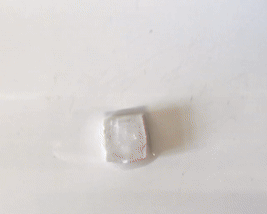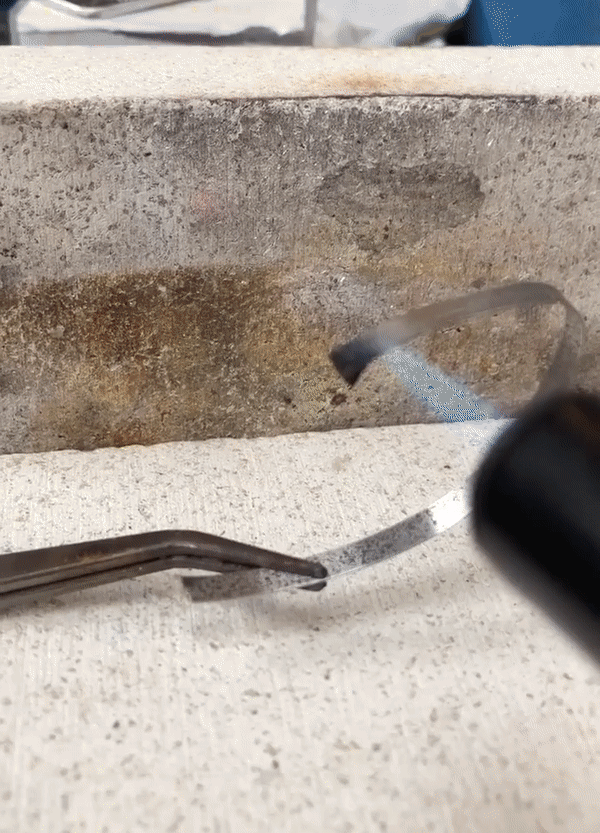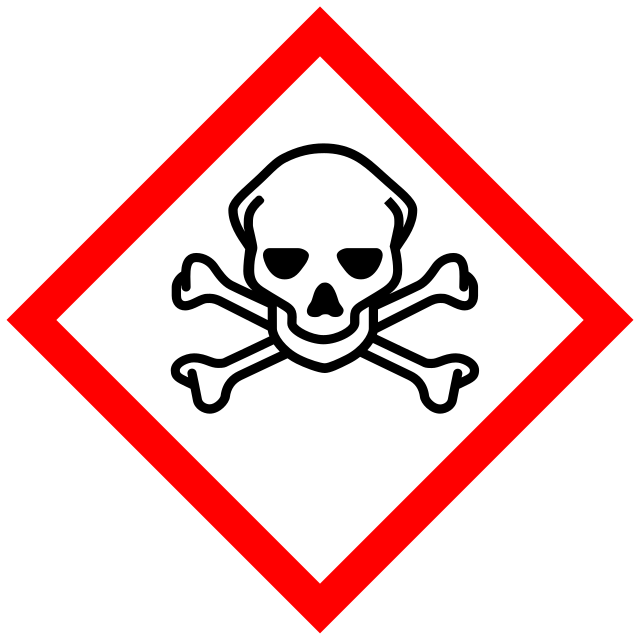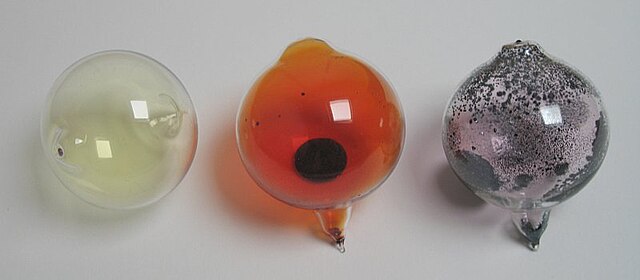
Periodicity (GCSE)
KS4 National Curriculum Statement(s) covered
- Properties and trends in properties of elements in the same group
- Chemical reactivity of elements in relation to their position in the Periodic Table
Skip to:
Periodicity refers to the recurring trends and patterns in the properties of elements as you move across periods and down groups in the Periodic Table. Understanding these trends helps explain the similarities and differences in chemical behaviour among elements in the same group.
Group 1 (Alkali Metals)
Group 1 elements, also known as alkali metals, include lithium, sodium, potassium, rubidium, caesium, and francium. These metals are characterised by having a single electron in their outer shell, which makes them highly reactive, especially with water. Like all groups in the Periodic Table, there are trends in the physical properties and chemical properties of the elements.
Physical properties:
Alkali metals are soft and can be cut with a knife. Their softness increases down the group due to the increased atomic size, which weakens the metallic bonds. On the outside the metals are dull, but when cut, a shiny metal interior is revealed.

The alkali metals have low densities because they have relatively large atomic radii and low atomic masses. Density generally increases down the group, except for an anomaly at potassium. For example, lithium (0.53 g/cm³) is less dense than sodium (0.97 g/cm³).
These metals have relatively low melting points and boiling points, which decrease down the group. This is because the metallic bonds become weaker as atomic size increases. For instance, lithium melts at 180.5°C, while caesium melts at 28.5°C.
Chemical properties:
The reactivity of the Group 1 elements increases down the group. This is due to the outer shell of their atoms being further away from the nucleus, making it easier to lose the outermost electron (as it is less attracted to the positively charged nucleus).
Alkali metals are stored in oil to prevent them from reacting with moisture and oxygen in the air. Due to their high reactivity, especially with water, they can form hydroxides and hydrogen gas, which can be explosive. For example, lithium reacts moderately with water, while potassium reacts very vigorously. Here are the reactions with water:
- Word equation: lithium + water → lithium hydroxide + hydrogen
Symbol equation: 2Li (s) + 2H₂O (l) → 2LiOH (aq) + H₂ (g) - Word equation: sodium + water → sodium hydroxide + hydrogen
Symbol equation: 2Na (s) + 2H₂O (l) → 2NaOH (aq) + H₂ (g) - Word equation: potassium + water → potassium hydroxide + hydrogen
Symbol equation: 2K (s) + 2H₂O (l) → 2KOH (aq) + H₂ (g)

Potassium reacts so violently with water, the energy released is enough to ignite the hydrogen gas. As the gas burns, so does some of the potassium - glowing lilac. It may even spark.
Sometimes sodium will also burn, producing a yellow flame.
Alkali metals also react with halogens to form ionic salts. For example:
- Word equation: sodium + chlorine → sodium chloride
Symbol equation: 2Na (s) + Cl₂ (g) → 2NaCl (s)
The alkali metals get their name, as when they react with water they form an alkaline solution (due to the formation of hydroxides). This can be shown by addition of an chemical indicator:

Universal indicator (UI) is green in neutral solutions, and turns blue in the presence of an alkali.
Group 2 (Alkaline Earth Metals)
Group 2 elements, known as alkaline earth metals, include beryllium, magnesium, calcium, strontium, barium, and radium. These elements have two electrons in the outer shell of each atom, making them reactive, though less so than alkali metals.
Physical properties:
Alkaline earth metals are harder than Group 1 metals because they have stronger metallic bonds due to two outer electrons. Density generally increases down the group. For example, magnesium has a density of 1.74 g/cm³, while barium has a density of 3.62 g/cm³.
These metals have higher melting and boiling points than alkali metals, which decrease down the group. For instance, magnesium melts at 650°C, while barium melts at 727°C. The larger atomic size down the group weakens the metallic bonds, leading to lower melting and boiling points.
Chemical properties:
Alkaline earth metals are reactive, and their reactivity increases down the group. This is due to the outer shell of their atoms being further away from the nucleus, making it easier to lose the two outer electrons (as they less attracted to the positively charged nucleus). For example, calcium is more reactive than magnesium. Here are the reactions with water:
- Word equation: magnesium + water → magnesium hydroxide + hydrogen
Symbol equation: Mg (s) + 2H₂O (l) → Mg(OH)₂ (aq) + H₂ (g) (slow reaction with cold water) - Word equation: calcium + water → calcium hydroxide + hydrogen
Symbol equation: Ca (s) + 2H₂O (l) → Ca(OH)₂ (aq) + H₂ (g) (vigorous reaction with cold water)
When magnesium reacts with oxygen, it burns with a bright white flame and produces a white powdery ash called magnesium oxide. The reaction can be represented by the following word and symbol equations:
- Word equation: magnesium + oxygen → magnesium oxide
Symbol equation: 2Mg (s) + O₂ (g) → 2MgO (s)

Magnesium oxide, like other metal oxides, is alkaline when it dissolves in water, forming an alkaline solution of magnesium hydroxide (Mg(OH)₂). On the other hand, non-metal oxides are usually acidic. For example, when carbon dioxide dissolves in water, it forms carbonic acid:
- Word equation: carbon dioxide + water → carbonic acid
Symbol equation: CO₂ (g) + H₂O (l) → H₂CO₃ (aq)
Other Group 2 metals (beryllium, calcium, strontium, barium, and radium) react with oxygen in a similar manner, forming metal oxides. These reactions typically involve burning with varying intensities of flames and producing corresponding metal oxides.
Group 7 (Halogens)
Group 7 elements, known as halogens, include fluorine, chlorine, bromine, iodine, and astatine. These non-metals have seven electrons in their outer shell, making them highly reactive, particularly with alkali metals and alkaline earth metals.

Uses:
Halogens have various uses. Chlorine is used to disinfect water, making it safe for drinking and swimming. Iodine is essential in the human diet for thyroid health and is used as an antiseptic. Fluorine is used in toothpaste to help prevent dental cavities. However, halogens can be toxic; chlorine gas, for example, was used as a chemical weapon during World War I, and inhaling it can cause severe respiratory damage.

Physical properties:
Halogens exist in different states at room temperature: fluorine and chlorine are gases, bromine is a liquid, and iodine and astatine are solids. Their melting and boiling points increase down the group due to stronger intermolecular forces of attraction as their molecules become larger (more energy is needed to overcome these forces). For example, chlorine boils at -34°C, while iodine boils at 184°C.
They have distinctive colours: chlorine gas (Cl₂) is pale green, bromine liquid (Br₂) is brown, and iodine solid (I₂) is purple-black. Iodine will sublime, skipping the liquid state at room pressure, and produce a lilac gas.
Chemical properties:
Chemically, halogens are highly reactive, with reactivity decreasing down the group. Fluorine is the most reactive due to its small atomic radius, which makes it easier to attract electrons as the nucleus is closer and has a stronger attractive pull.
They readily form salts with metals. For example:
- Word equation: sodium + chlorine → sodium chloride
Symbol equation: 2Na (s) + Cl₂ (g) → 2NaCl (s)
Group 7 elements will react with hydrogen to form hydrogen halides (which dissolve in water to form acidic solutions):
- Word equation: chlorine + hydrogen → hydrogen chloride
Symbol equation: Cl₂ (g) + H₂ (g) → HCl (g)
More reactive halogens can displace less reactive halogens from their compounds. For example:
- Word equation: chlorine + potassium bromide → potassium chloride + bromine
Symbol equation: Cl₂ (g) + 2KBr (aq) → 2KCl (aq) + Br₂ (l)
Group 0 (Noble Gases)
Group 0 elements, known as noble gases, include helium, neon, argon, krypton, xenon, and radon. These elements are characterised by having a complete outer shell of electrons, making them very stable and unreactive. They are described as being inert. This means the elements exist as monatomic substances, no need for them to react and bond with other atoms.

Noble gases, such as helium, neon, argon, krypton, and xenon can emit light when an electric current passes through them. When electricity passes through a noble gas, it provides energy to the gaseous atoms. This energy excites the electrons in the atoms, causing them to jump to higher energy levels. The excited electrons do not stay in the higher energy levels for long. They quickly return to their original, lower energy levels. As the electrons drop back to their lower energy levels, they release the excess energy in the form of light.

Uses:
Helium is used in balloons and as a cooling medium for superconducting magnets. Neon is used in brightly coloured advertising signs. Argon is used in lightbulbs and in welding to provide an inert atmosphere, preventing the hot metal from reacting with oxygen.
Physical properties:
Noble gases are colourless, odourless gases at room temperature. Their boiling points increase down the group because the atoms become larger and have more electrons, which leads to stronger forces of attraction between atoms. For example, helium boils at -269°C, while radon boils at -61°C.
Density also increases down the group; helium is much less dense than air, while radon is denser.
Chemical properties:
Noble gases are largely inert due to their full electron shells, making them very stable and non-reactive. This is why they are often used in situations where reactions are not desired, such as in light bulbs (argon) and neon signs.
Under extreme conditions, some noble gases can form compounds. For instance, xenon can react with fluorine to form xenon hexafluoroplatinate (XePtF₆).
Transition Metals
Transition metals, including elements like iron, copper, nickel, and gold, are located in the centre of the Periodic Table. These metals have variable properties and can form coloured compounds.
Roman numerals are used to indicate the charge of the ions in the names of these compounds. For example, iron(Ⅲ) oxide (Fe₂O₃) indicates that iron has a charge of +3, and copper(Ⅱ) chloride (CuCl₂) indicates that copper has a charge of +2.
Uses:
Iron is used in construction and manufacturing due to its strength and durability. Copper is widely used in electrical wiring and plumbing because of its excellent conductivity and malleability. Nickel is used in stainless steel production and batteries. Gold is used in jewellery and electronics due to its resistance to corrosion and excellent conductivity.
Physical properties:
Transition metals have typical properties of metals, including high melting and boiling points, high density, shiny when polished and good conductors of heat and electricity. The melting and boiling points are much higher than the Group 1 metals. For example, chromium (Cr) has a melting point of 1907°C, much higher than sodium’s 98°C.
Transition metals are also stronger and harder than Group 1 metals. Iron (Fe), for example, is much harder and stronger than potassium (K). This makes them useful in construction (iron and steel).

Chemical properties:
Transition metals form ions with different charges. For example, iron can form Fe²⁺ and Fe³⁺ ions, while copper can form Cu⁺ and Cu²⁺ ions. These metals also form coloured compounds, such as:
- potassium dichromate (K₂Cr₂O₇), which is orange
- manganese dioxide (MnO₂), which is black
- copper(Ⅱ) sulfate, which is blue
- nickel(Ⅱ) chloride, which is green
Transition metals can form multiple different coloured compounds, and sometimes the same ion can be different colours depending on the anion involved. Iron as an example:
- iron(Ⅱ) hydroxide - pale green
- iron(Ⅲ) hydroxide - orange/brown
- iron(Ⅲ) oxide - red/brown

The transition metals often act as catalysts in chemical reactions. For example:
- iron (Fe) is used in the Haber process to synthesise ammonia
- nickel (Ni) is used in the hydrogenation of alkenes
- vanadium(V) oxide (V₂O₅) is used in the Contact process to produce sulfuric acid
In terms of reactivity, transition metals are less reactive than Group 1 metals. They do not react as vigorously with oxygen, water, or halogens. For example, iron reacts slowly with oxygen and water to form rust (iron oxide), while sodium reacts rapidly to form sodium oxide. Here are some example reactions:
- Word equation: iron + oxygen + water → hydrated iron(Ⅲ) oxide
Symbol equation: 4Fe (s) + 3O₂ (g) + 6H₂O (l) → 4Fe(OH)₃ (s) - Copper does not react with water at room temperature, demonstrating its lower reactivity compared to Group 1 metals.
Listen to this page (feature coming soon)
Did you know?
- Strontium and barium, both Group 2 metals, are used in fireworks to produce red and green colours, respectively.
- Helium-neon lasers, which emit a bright red light, are commonly used in barcode scanners and laser pointers.
- Caesium, an alkali metal, is used in atomic clocks, which are the most accurate timekeeping devices in the world. These clocks measure time based on the vibrations of caesium atoms and are so precise that they would only lose one second in millions of years.
- Astatine, the rarest naturally occurring halogen, is so scarce that it's estimated there are only about 25 grams of it in the Earth's crust at any given time. It is highly radioactive and has been difficult to study due to its short half-life and rarity.
Why do we care?
- Group 1 elements (alkali metals) like lithium, sodium, and potassium are highly reactive and used in batteries, chemical synthesis, and even in fireworks for their bright colours.
- Group 2 elements are found in bones (calcium) and are used in products like antacids (magnesium) and fireworks.
- Group 7 elements (halogens) like chlorine are used in disinfectants to keep our water safe, and iodine is used in medical antiseptics.
- Group 0 elements (noble gases) are used in neon lights and provide non-reactive atmospheres for preserving historical documents.
- Transition metals like iron are crucial for construction, copper is essential for electrical wiring, and catalysts like platinum are used in industrial chemical reactions to speed up processes efficiently.
Key information
- Alkali metals are soft and can be cut with a knife.
- Alkali metals are highly reactive, especially with water, forming hydroxides and hydrogen gas. Reactivity increases down the group.
- Halogens exist in different states at room temperature: fluorine and chlorine are gases, bromine is a liquid, and iodine and astatine are solids. Their melting and boiling points increase down the group.
- Halogens are highly reactive, with reactivity decreasing down the group.
- Noble gases are colourless, odourless gases at room temperature with boiling points that increase down the group. They are very low in density.
- Noble gases are inert due to their complete outer electron shells, making them stable and non-reactive.
- Transition metals have high melting and boiling points, are strong and hard, and are good conductors of heat and electricity.
- Transition metals form ions with different charges and create coloured compounds. They often act as catalysts in chemical reactions and are less reactive than Group 1 metals.